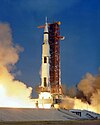Saturn C-8
This article needs additional citations for verification. (March 2011) |
 Saturn C-8 Launch Vehicle | |
| Function | Manned lunar landing by direct ascent for Apollo program |
|---|---|
| Manufacturer | None |
| Country of origin | United States |
| Size | |
| Height | 430 ft (131 m) |
| Diameter | 40 ft (12.2 m) |
| Width | 75 ft (22.9 m) |
| Mass | 10,516,620 lb (4,770,260 kg) |
| Stages | 3 |
| Capacity | |
| Payload to Translunar injection | |
| Mass | 163,000 lb (74,000 kg) |
| Associated rockets | |
| Family | LH2 / LOX |
The Saturn C-8 was the largest member of the
Saturn series of rockets to be designed.[1] It was a potential alternative to the Nova rocket, should NASA have chosen a direct ascent method of lunar exploration for the Apollo program. The first stage was an increased-diameter version of the S-IC. The second stage was an increased-diameter version of the S-II. Both of these stages had eight engines, as opposed to the standard five. The third stage was a stretched S-IVB
stage, which retained its original diameter and engine.
NASA announced on September 7, 1961, that the government-owned
F-1 engines
(Saturn C-8, Nova class) could not be built; four or five engines (33 ft or 10 m diameter) would have to be the maximum.
This decision ended consideration of a Nova-class launch vehicle for direct ascent to the Moon or as heavy-lift derivatives for Earth orbit rendezvous. Ultimately, the lunar orbit rendezvous ("LOR") concept approved in 1962 rendered the C-8 obsolete, and the smaller Saturn C-5 was developed instead under the designation "Saturn V", as the LOR spacecraft was within its payload capacity.
The Saturn C-8 configuration was never taken further than the design process, as it was too large and costly.
References
- ^ Wade, Mark. "Saturn C-8". Astronautix. Archived from the original on September 2, 2016. Retrieved 9 March 2020.
- Bilstein, Roger E, Stages to Saturn, US Government Printing Office, 1980. ISBN 0-16-048909-1. Excellent account of the evolution, design, and development of the Saturn launch vehicles.
- Stuhlinger, Ernst, et al., Astronautical Engineering and Science: From Peenemuende to Planetary Space, McGraw-Hill, New York, 1964.
- NASA, "Earth Orbital Rendezvous for an Early Manned Lunar Landing," pt. I, "Summary Report of Ad Hoc Task Group Study" [Heaton Report], August 1961.
- David S. Akens, Saturn Illustrated Chronology: Saturn's First Eleven Years, April 1957 through April 1968, 5th ed., MHR-5 (Huntsville, AL : MSFC, 20 Jan. 1971).
- Final Report, NASA-DOD Large Launch vehicle Planning Group, NASA-DOD LLVPG 105 [Golovin Committee], 3 vols., 1 Feb. 1962
![]() This article incorporates public domain material from websites or documents of the
This article incorporates public domain material from websites or documents of the
National Aeronautics and Space Administration
.
External links
- Diagram of C-8 with alternate 2-engine 3rd stage (not to the same proportions as the image above)

